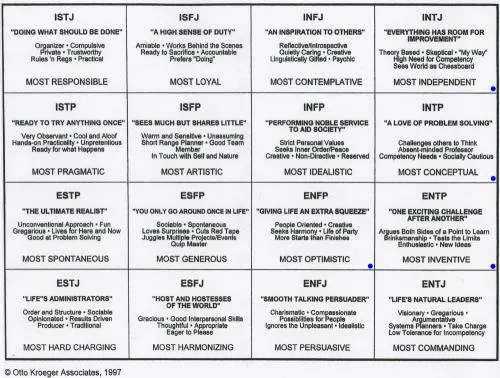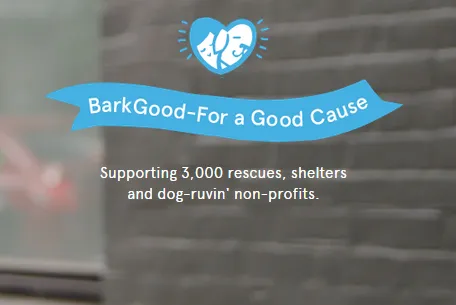Intro to Myers-Briggs Personality Types
Imagine you’re at a party and this party represents all of your target customers. As with any party, some people are talking in a large group in the center of the room while some chat in small groups of two or three around the outside.
You’re witnessing the natural segmentation of personality types.
For marketers, it’s crucial to communicate with each of these groups differently. Because they all have different needs and preferences as people.
Personality targeting has been shown to improve the effectiveness of advertising campaigns. The best brands do and so can you.
This post is going to discuss how to target user segments with the principles of the Myers-Briggs Type Indicator (MBTI). Since the early 1900s, this psychological assessment has helped businesses and individuals develop and refine their understanding of humanity’s inherent variability.
We're going to show you how to target extroverts and introverts, as well as each of the personality types represented in the Myers-Briggs Personality test. With examples from successful consumer brands, this piece will give marketers all the information they need to understand and refine their messaging for their ideal customer groups. We’ll talk about how to use personas, copy, and multi-channel methods to reach your audience.
What is the Myers-Briggs Type Indicator?
Based upon the theories of famous Swiss psychologist Carl Jung, the Myers-Briggs Type Indicator is a questionnaire created by a mother-daughter pair of psychologists to group people by “personality inventory.”
Try it for yourself and see just how accurate it is. It should only take a few minutes.
Based upon answers from a questionnaire, the test places respondents into one of 16 different personality types. These types are based on four dichotomies of character:
- Introversion or Extroversion (Source of energy)
- Sensing or Intuition (Attention filters)
- Thinking or Feeling (Decision making process)
- Judging or Perception (Life-structuring principles)
Between the available combination of personality types, your brand may have customers in many or only a few types. Recognizing which type of person you're attracting can influence strategy, improve tactics and increase your revenue.
(Source)
Imagine your brand appeals most to ESFP (Extroverted, Sensing, Feeling, Perceiving) people, the most generous of extroverted personality types listed above. It would be wise to speak to these customers in a language that caters to their outgoing good nature. Surprising them with clever social media updates is a great idea, as is inviting them to engage with your brand across multiple channels and bring others along for the ride.
Say INTP (Introverted, Intuitive, Thinking, Perceiving) introverts are a large part of your company's success. These individuals love a challenge but are socially cautious, so bring them into your brand story with big ideas. Encourage them to read informative emails sequences about brand concept and challenges - but don’t expect them share or like your social media posts.
Smart marketers have long set out to draw user personas around each of these personality profiles. Always looking for new ways to segment users, the best companies cater their brand messaging, delivery, and copy to compliment the personal needs of their target market.
Targeting with the Myers-Briggs Type Indicator
To cluster people most effectively for targeting, we need to understand the basic dichotomies.
How are You Energized: Introversion or Extroversion?
Extroverts are the life of the party because they’re gaining energy from each new interaction.
Outgoing tendencies develop momentum and elevate these people to new heights while in the company of others.
Introverts are the opposite: each interaction drains energy from an introvert. Being alone is the most mentally rewarding state for introverts, so they tend to stick to themselves.
Author and psychologist Dan Pink reminds us that these tendencies exist on a spectrum and most people are ambiverts,
“Neither overly extraverted nor wildly introverted.” To Sell is Human: The Surprising Truth About Moving Others
Being shy or loud has nothing to do with introversion or extroversion - all that matters is how these two personality types react to stimulus in their environment.
Understand this fundamentally opposite relationship to social interaction and you’ll be able to prompt action along the lines of energy in your users.
Let’s look at some specifics.
Extroverts:
- Receive energy through social interaction and are excited by others
- Like to make things happen and try new things right away
- Understand ideas better through sharing in conversation with others
- Are comfortable in groups and like working with others
- Are more prone to action
- Are described as “outgoing” or as a “people person”
Because extroverts receive energy from social interaction, it’s always a good time to talk with them (unless they're busy). They feel drained if they spend too much time alone.
Extroverts like to talk to others and are more likely to respond to calls, real-time messaging, and events. The more engaging, the better. Social media channels are great, live chat support features, as is copy that features people and hinges around action words and conversation.
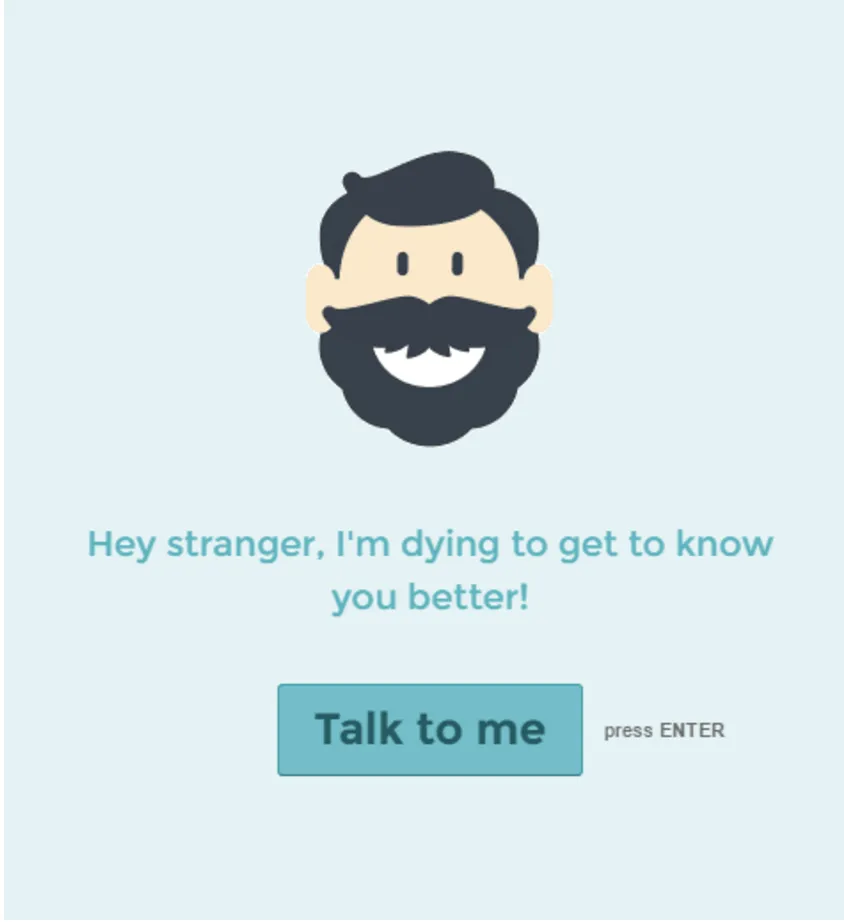
(Source)
A friendly face and a chat icon is a perfect way to engage an extrovert. Copy that uses language like “Talk to me” is sure to ignite the extroverts sense of excitement and prompt engagement.
A recent study found that extroverts regard social media as a good way to meet new people. They also thought it was ideal for interacting with those that share similar interests and professional ties. When it came to Facebook specifically, extroverts were almost twice as likely to engage than introverts. Keep in mind that many of the likes and shares you get may be the outward-going types. This doesn’t mean your introverts aren’t reading and enjoying your content but they’re just not acting on it in the same way.
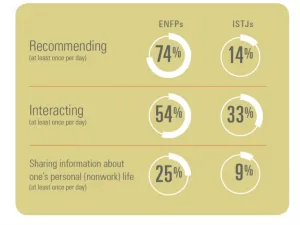
(Source)
In the 1960’s, psychologist Hans Eysenck conducted research which showed extroverts had a higher threshold for cognitive arousal, suggesting that additional stimulation was required ot promote action. Eysenck attributed the extroverts craving for novelty, adventure, and the company of others to a need to achieve their satisfying mental state. This state was readily available to introverts found through quieter, less “involved” mental pursuits.
Video marketing is an ideal way to engage introverts in both a visual and auditory way, providing more excitement than static text and unmoving images.

(Source)
This Dollar Shave Club ad goes after extroverts with action-oriented CTAs, minimal text, and a an edgy video to convey the message. The brand also recognizes the wide social network that extroverts enjoy, allowing the their outgoing users to work for the brand by sharing and referring other customers. Extroverts love referral programs because it helps them connect with others.
Introverts:
Research has shown that introverts and extroverts process stimuli differently. For extroverts, the pathway is short and runs through the area of the brain responsible for taste, touch, visual and auditory sensory processing.
Stimuli reaches introverts through a longer, more complicated pathway via areas of the brain associated with remembering, planning and problem solving. This supports fast-paced idea of extroverts, one ready for action when given the right incentive.
These individuals:
- Get their energy from ideas, pictures, memories, and their mental space
- Prefer to act alone or with one or two others in a small group they already feel comfortable around
- Reflect before acting and are more reserved
- Feel most comfortable being alone
- Are more prone to planning than acting

(Source)
This ad from Blue Corona Marketing perfect captures the desired peace and tranquility introverts need for optimum functioning.
Since being around others is energetically draining for introverts, craft content and use channels that allow them to digest information on their own and allow them time to react. Blog posts, emails, white papers are all great engagement tools.
Introverts are accustomed to intaking and processing lots of information on their own. More classically your reader-type than extroverts, count on having introverts’ attention as long as the copy is compelling.
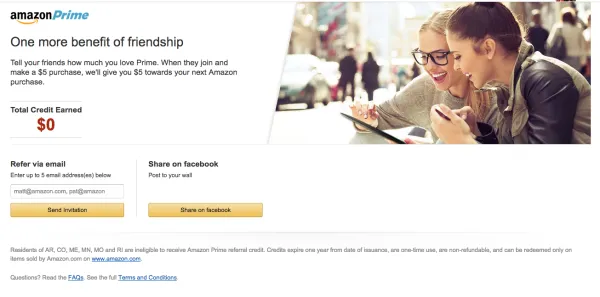
Not flashy but full of information, this Amazon Prime referral message is ideal for introverts. Lots of text is fine for readers, as is the option between sharing the benefits though email or social. Many introverts prefer to stick with email and shy away from social settings - even online.
Socially, introverts keep a tight-knit group of friends and prefer to engage with those they already know. Since their group is smaller, the appeal to share altruistic rewards is stronger. The messaging by Prime is slick, relevant to the introverts who might need a reminder to get more engaged with others.
Now that we’ve looked at introverts and extroverts, let’s consider the other relevant personality factors from the Myers-Briggs test.
How Do You Pay Attention to the World: Sensation or Intuition?
The next letter in the acronym addresses how someone uses their faculties to perceive what’s going on around them. Are they more tuned into their physical body or their unconscious mind?
Sensing Types:
- Pay attention to immediate data from the five senses and life experiences
- Trust their conscious brain to create meaning
- Focus their attention upon facts and data
- Go after details to find the truth
- Orient themselves with the practical and real instead of the revolutionary
- Apply logic and sequential thinking
With sensation centered individuals, be sure to show evidence such as fact and examples. Customer testimonials and statistic will be well received with sensors intent to make decisions in a well-rounded and well-thought-out fashion. Messaging copy that’s direct and factual is best.

(Source)
This ad from Dollar Shave Club is just the style to appeal to the straightforward and nonsense sensor types.
Intuitive Types:
These people are more abstract in their approach to understanding, processing information more deeply and across a wider mental network than the sensors. Intuitive persons:
- Trust their subconscious mind and gut responses
- Are good at spotting patterns and looking at information from a wider perspective
- Like ideas and inspiration
- Focus on the future and plan into a perfect present rather than the imperfect “now”
- Enjoy working on a strategic level and acquiring new skills
To reach intuitors, present the big ideas and concepts first and then move into the details (if at all). Instagram carousel campaigns are a great way to inspire and prompt their intuitive capabilities.
These people take ideas at face value until proven incorrect, so painting a vivid picture in their minds is important to achieve engagement. Storytelling email sequences that attend to their imagination, or a video that develops your brand in a creative way will be well received.
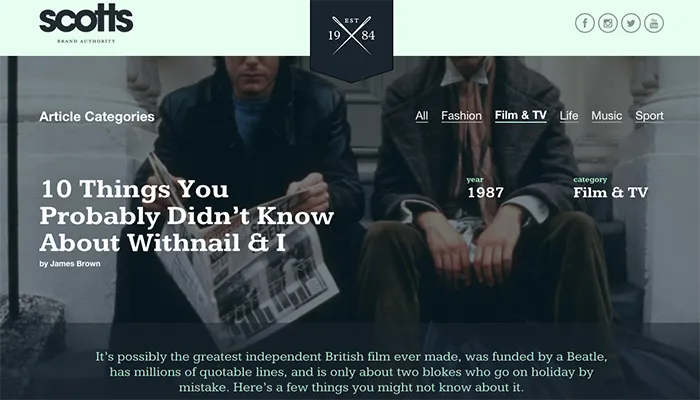
Ecommerce retailer Scotts Menswear uses their website to spark curiosity with intuitive types. The article headline clearly invites readers to delve further into the concept of the brand while the supporting text hearkens to the grand old times of the Beatles and great British films.
How Do You Make Decisions: Thinking or Feeling?
Targeting users along the lines of their decision making processes have obvious advantages. Some will make decisions along the lines of emotions and others will stick to facts and data.
Creating personas with precise messaging for both types of customers can reach prospects in via this most direct aspect of their personality.
Thinking Types:
- Find the fundamental principle of each situation
- Analyze pros and cons for logical decisions
- Try to be impersonal and disregard wishes of self or the influence of others
- Notice inconsistencies
- Believe truth is more important than tact
- See in black and white
- Are task oriented and seek to create value
Thinkers appreciate concise interactions. It’s best to approach them with reason on your side but feelings and emotions can be used to add weight to a decision.
AO Life wastes no time in providing value on their homepage, which thinker-types appreciate. It’s factually grounded, objective and intellectually critical and provides “How to” articles for added daily efficiencies. With thinkers it’s important to emphasize what’s in it for them.
Feeling Types:
- Orient themselves with people or communication
- Make decisions by weighing the concerns and cares of multiple people
- Concern themselves with harmony in a group
- Make decisions based around compassion
- Believe that tact is sometimes more important than truth
Feeling-types respond well to rapport-building and sometimes developing trust can take bit longer. Nurturing sequences are perfect for feelers, so long as the copy is personable and friendly. Demonstrating empathy and how your brand helps others is a must so referral programs with reciprocal rewards are huge with this group. These individuals value the “how” almost as much as the “what.”
Conscious values are incredibly important.
(Source)
BarkGood messaging really connects with those in the heart-forward group. This image communicates their kind and caring brand image with “dog-ruvin’” and reader-friendly copy. Viewers instantly feel warm and fuzzy, whether this image is delivered through email, social media, or in-app messaging. Anytime is a good time for appropriate feel-good messages.
How Do You Structure Your Life: Perceiving or Judging?
The Sensing/Intuition function determines the outer order of a person's life, while the Perceiving/Judging dichotomy regulates a person’s internal processes.
In this sense, “perceiving” means “preferring to take in information.” It doesn’t mean observant. Here, it’s about how someone appreciates a less structured existence which is more open to new influences and information.
Perceiving Types:
- Prefer a flexible and spontaneous way of life
- Like to understand and adapt to circumstances rather than organize
- Work in bursts of activity and are stimulated by approaching deadlines
- Hold off making decisions until the last minute with up-to-date information
Perceivers are all about flow and new possibilities. Presenting them with limited time promotional offers and discounts can be very effective in influencing purchases. Because of their open-air schedule, this type needs autonomy and freedom and doesn’t like to be bothered unless it’s relevant. Minimize messaging here, focus instead upon delivering quality and actionable value instead of just saying “Hi.”
This group isn’t impulsive, they’re just ready to change directions quickly given the latest updates.

(Source)
Here’s Modify Watches staying current with their perceiver-types on Instagram. This sponsored post brings value in the form of a $10 savings and prompts viewers to update their style for summer with new colors. This type of time-sensitive advertising can bring out the buyer in perceivers with the latest and greatest deals.
Judging Types:
- Prefer a planned and orderly way of life
- Like organization and feel more comfortable when all decisions have been made
- Like to feel like everything's under control
- Want work to come before play
- Plan for deadlines
Making choices early allows judging types to clear their mental space and feel at peace. This sense of control is very rewarding, so helping this group coordinate their life, gather valuable information, and pre-purchase goods can very valuable for both brand and consumer.
Announcing sales or new products in a newsletter appeals directly to the sense of order these individuals crave. High in self disciple, judgers seek closure in decisions and expect deliverables to be exactly to specifications. Following up sales with surveys is great here, since this group likes to be listened to and to be considered an expert.
The judging type loves to hear about product updates and account changes, as it help them plan accordingly. Vintage retailer ModCloth turns a weekly newsletter into a fashion-prep reminder. Besides updating viewers with relevant feature and account information, new styles for impending occasions increase the value of the messaging. Consistent updates help judging individuals keep tabs and ModCloth presents not one but three separate incentives to purchase a new dress: a rehearsal dinner, a cake tasting, and a wedding.
Takeaways
This has been a breakdown of the Myers-Briggs Personality Indicator and how to target user segments given the innate characteristics of each group. To make the most out of your permission marketing, engaging your target customers while respecting their preferences is essential.
First, be highly conscious of whether you’re dealing with extroverts or introverts. Introverts will engage less with social media but are better at reading information, whereas extroverts need social outlets and prefer highly stimulating messaging channels.
To target Sensing/Intuitive types effectively, remember to speak the language of data and reason or stick to more abstract ideas and concepts. Thinkers/Feelers are similarly opposite because thinkers want to know what’s in it for them and want up-front information.
Feeling-types are going to respond well to conscientious and group-oriented messaging that acknowledges the needs of others. People also vary along how they structure their life, so if you’re targeting piercing-types be sure to appeal to their want for only the most current and relevant information; judging-types want the to know everything that could influence their need for prior planning, so deliver these individuals the content what they need to relax.
Whether drawing up customer personas or creating content, be sure to acknowledge these differences in your users and segment accordingly for the best results.
